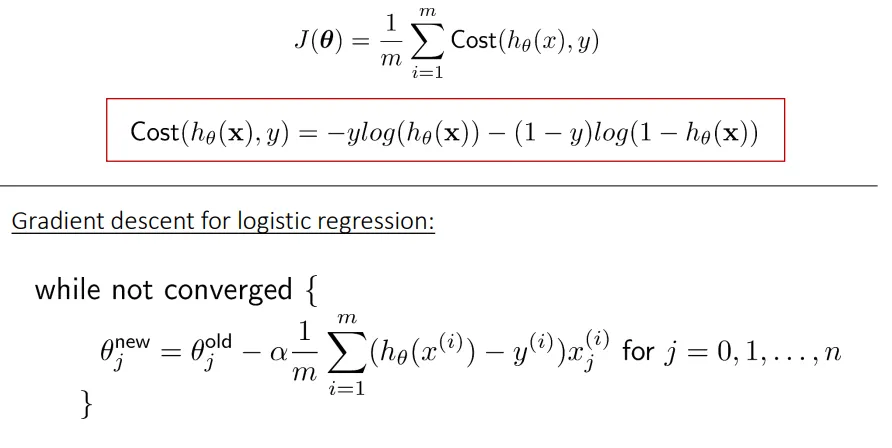看起来你的一些东西混在了这里。在这样做时,关键是要跟踪向量的形状并确保你得到合理的结果。例如,你正在使用以下方法计算成本:
cost = ((-y) * np.log(sigmoid(X[i]))) - ((1 - y) * np.log(1 - sigmoid(X[i])))
在你的情况下,y 是一个有 20 项的向量,而 X[i] 是一个单一的值。这会使得你的成本计算成为一个 20 项的向量,这是没有意义的。你的成本应该是一个单一的值。(此外,在梯度下降函数中你还不必要地多次计算了这个成本)。
另外,如果你想让它适应你的数据,你需要给 X 添加偏置项。所以我们从那里开始吧。
X = np.asarray([
[0.50],[0.75],[1.00],[1.25],[1.50],[1.75],[1.75],
[2.00],[2.25],[2.50],[2.75],[3.00],[3.25],[3.50],
[4.00],[4.25],[4.50],[4.75],[5.00],[5.50]])
ones = np.ones(X.shape)
X = np.hstack([ones, X])
# X.shape is now (20, 2)
现在Theta每个X需要2个值,因此初始化X和Y:
Y = np.array([0,0,0,0,0,0,1,0,1,0,1,0,1,0,1,1,1,1,1,1]).reshape([-1, 1])
Theta = np.array([[0], [0]])
你的Sigmoid函数很好。我们也可以制作一个向量化的成本函数:
def sigmoid(a):
return 1.0 / (1 + np.exp(-a))
def cost(x, y, theta):
m = x.shape[0]
h = sigmoid(np.matmul(x, theta))
cost = (np.matmul(-y.T, np.log(h)) - np.matmul((1 -y.T), np.log(1 - h)))/m
return cost
成本函数有效的原因是因为Theta的形状为(2,1),而X的形状为(20,2),因此matmul(X, Theta)将被调整为(20,1)。然后将其与Y的转置矩阵相乘(y.T的形状为(1,20)),得到单个值,即给定特定Theta值时的成本。
然后我们可以编写一个函数来执行批量梯度下降的单个步骤:
def gradient_Descent(theta, alpha, x , y):
m = x.shape[0]
h = sigmoid(np.matmul(x, theta))
grad = np.matmul(X.T, (h - y)) / m;
theta = theta - alpha * grad
return theta
注意:np.matmul(X.T, (h - y))正在计算形状为(2,20)和(20,1)的矩阵乘积,其结果为形状(2,1),这与Theta的形状相同,这就是您从梯度中想要的。这使您可以将其乘以学习速率并从初始的Theta中减去它,这就是梯度下降应该做的。
因此,现在您只需编写一个循环进行多次迭代,并更新Theta直到看起来收敛:
n_iterations = 500
learning_rate = 0.5
for i in range(n_iterations):
Theta = gradient_Descent(Theta, learning_rate, X, Y)
if i % 50 == 0:
print(cost(X, Y, Theta))
这将在每50次迭代中打印成本,导致成本稳步下降,这正是您所希望的:
[[ 0.6410409]]
[[ 0.44766253]]
[[ 0.41593581]]
[[ 0.40697167]]
[[ 0.40377785]]
[[ 0.4024982]]
[[ 0.40195]]
[[ 0.40170533]]
[[ 0.40159325]]
[[ 0.40154101]]
你可以尝试不同的Theta初始值,你会发现它始终收敛到相同的结果。
现在你可以使用新找到的Theta值进行预测:
h = sigmoid(np.matmul(X, Theta))
print((h > .5).astype(int) )
这将输出与您的数据线性拟合的预期结果:
[[0]
[0]
[0]
[0]
[0]
[0]
[0]
[0]
[0]
[0]
[1]
[1]
[1]
[1]
[1]
[1]
[1]
[1]
[1]
[1]]
